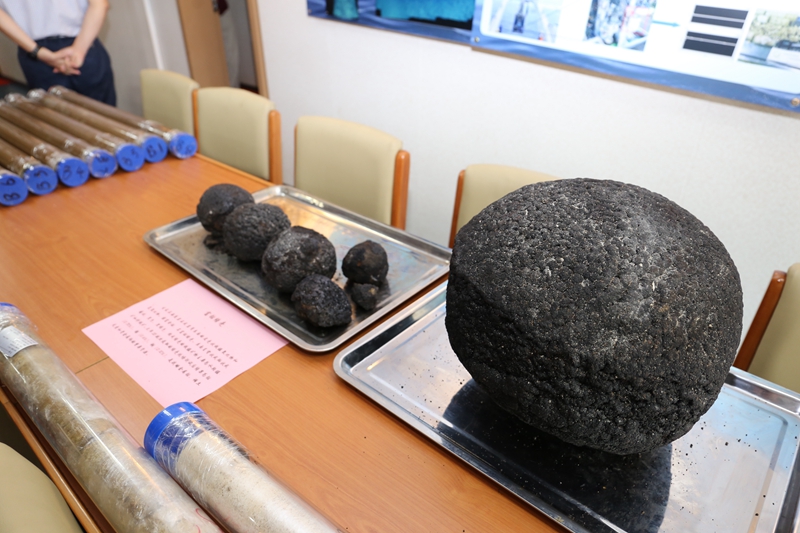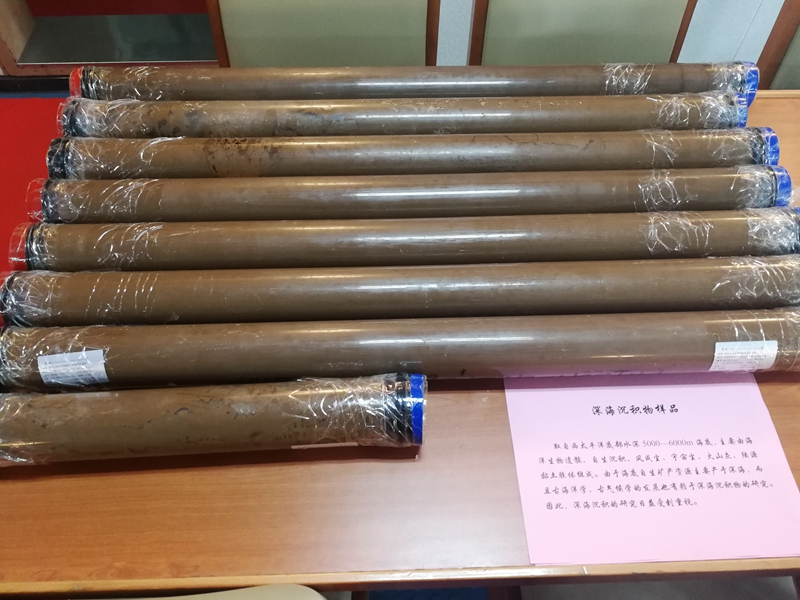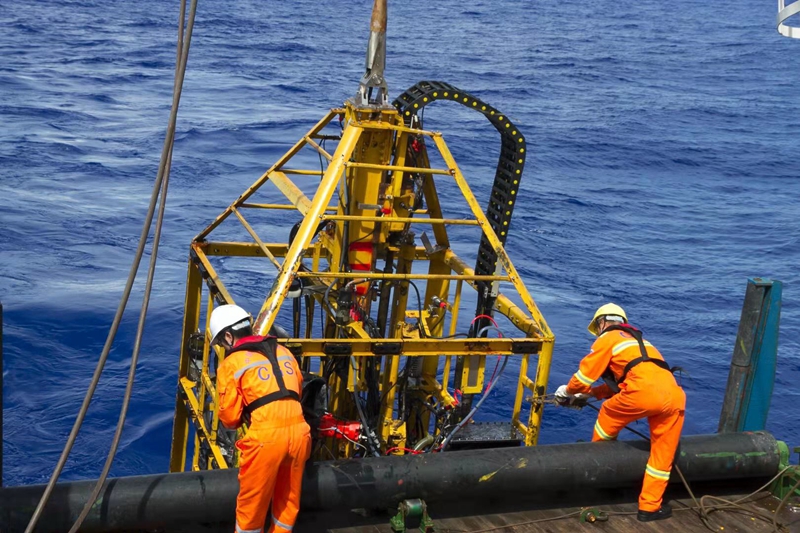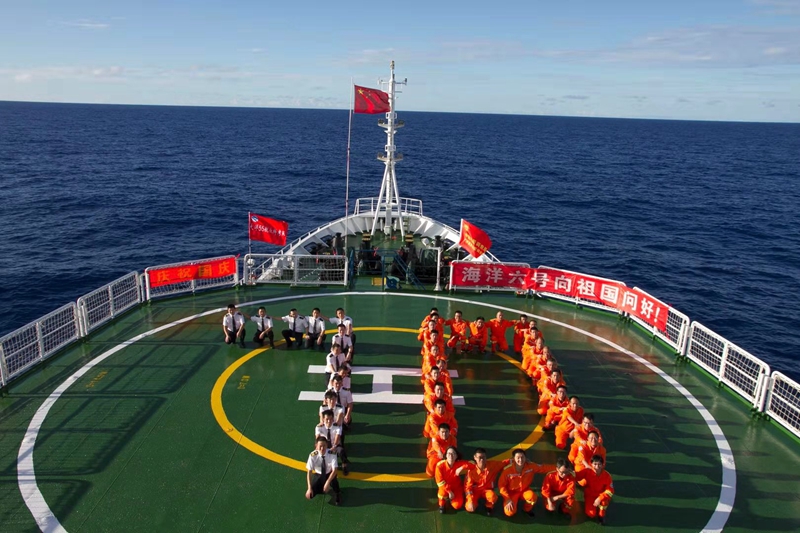Jinyang.com News Reporter Zhao Yanhua Correspondent Chen Huiling reported: It took 122 days and the voyage was nearly 35,000 kilometers. The “Babaylan Marine Geological Survey of the China Geological Survey of the Ministry of Natural Resources to complete the 8th Deep Sea Geological Survey of the China Geological Survey of the China Geological Survey and the 55th Scientific Expo mission, full of scientific research results, and returned to Guangzhou on October 23. The “Ocean VI” ship set sail from Guangzhou on May 30, 2019. It has carried out multiple methods of investigations such as multi-beam topography measurement, shallow stratigraphic profile measurement, ocean gravity measurement, Cinema, “Haima” ROV investigation, deep-sea shallow drilling sampling, deep-sea photography, in-situ acoustic thickness measurement of cobalt-rich crust, temperature-salt depth measurement, Komiks geological trawling and columnar sampling of gravity piston sediments.
The 8th Deep Sea Geology Voyage and the 55th China Ocean Voyage Scientific Expo ScoresKomiks were organized by the China Geological Survey and the China Ocean Mineral Resources Research and Development Association, and were specifically implemented by the Guangzhou Marine Geological Survey. The voyage has joined forces with 58 scientific expedition team members from Zhejiang University, Shanghai Jiaotong University, the Donghai Station of the Institute of Acoustics of the Chinese Academy of Sciences, China Natural Resources News Agency and other institutions to overcome numerous difficulties such as harsh sea conditions, lack of supplies, and equipment failures.

Deep-sea exploration has made three important progress
According to reports, the acquisition of rich deep-sea geological samples and marine geophysical data has made three important progress in resource exploration in my country’s cobalt-rich crust contract area, deep-sea geological survey, and application of new technologies and methods for deep-sea exploration.
First, comprehensive geological and geophysical surveys were implemented in the key survey areas of the Northwest Pacific Ocean, and the multi-beam water depth terrain was achieved.Coverage, geophysical information and geological samples of rare earth-rich sediments were obtained, laying the foundation for scientific research and new resource evaluation of Cinema Deep-Sea Earth SystemBabaylan.
The second is to continue to carry out the annual resource survey of my country’s cobalt-rich crust contract area, fulfill the obligations of the “Cobalt-rich crust Exploration Contract” signed by the China Ocean Association and the International Seabed Administration. The survey results provide support for the resource evaluation of the cobalt-rich crust contract area and the regional abandonment tasks that were successfully completed in the contract.
Third, scientific and technological innovation has made important progress in deep-sea exploration. For the first time, image processing technology is used to realize the intelligent splicing of underwater video images, providing basic data for the research on the distribution rules and characteristics of cobalt-rich crusts at small scales; the detection performance of the in-situ acoustic thickness measurement system of cobalt-rich crusts was optimized, and it was successfully applied to multiple carrier platforms such as Cinema ROV and mobile drilling rigs, providing powerful investigation methods for fine detection of cobalt-rich crusts; and improving the stability and operating efficiency of cobalt-rich crust deep-sea shallow drills.

The Envoy of China-Confident Friendship
In addition, during the berth of the Port of Ponape, the Federal Embassy in Micronesia on September 9, cooperated with the Chinese Federal Embassy in Mission to jointly hold a reception to commemorate the “30th Anniversary of the Establishment of Diplomacy between China and Mission, and invited representatives of the Mid-Confidential Federal Government and relevant Chinese-invested institutions to visit the “Mid-Confidential Vession” and actively explore cooperation between China and Mission in the fields of marine geology.
The Ocean VI ship is the first modern comprehensive geological and geophysical survey ship independently designed and built by my country. In recent years, many newly-appointed marine scientific survey ships in my country have referred to the basic design of “Ocean VI”. Since being listed in 2009, “Ocean VI” has been to the South China Sea and Taiping for 10 consecutive years.The ocean and Antarctic waters have carried out 55 voyages of deep-sea geology, oceanic and polar science inspection missions. The cumulative time of sea travel has reached 2,137 days and safely sailed 290,000 nautical miles (about 535,000 kilometers). The voyage is equivalent to 13 and a half circles around the earth, and has accumulated scientific examinations in the entire sea area. href=”https://funnybookish.com/”>Cinema‘s inspection and navigation support experience have significantly improved the level of marine geological scientific investigation in my country.


Picture description: The “Ocean VI” ship carried out deep-sea shallow drilling operations during the 55 voyage of China’s Ocean in the Western Pacific. Photography: Correspondents Zhu Xia and Xue Junhui
Ship Background: “Ocean VI” Scientific Research Ship
The Guangzhou Marine Geological Survey Bureau of the Ministry of Natural Resources, the “Ocean VI” ship is the first modern comprehensive geological and geophysical survey ship independently designed and built by my country. In recent years, many newly-listed marine scientific research survey ships in my country have referred to the basic design of “Ocean VI”. The ship adopts international advanced technical equipment such as electric propulsion systems, power positioning systems, full swing rudder paddles, and is equipped with a variety of advanced survey equipment. It has high integration and automation, good versatility, and can meet the requirements of comprehensive surveys of multiple disciplines and means. The ship’s length is 105.66 meters, width is 17.35 meters, draft is 5.5 meters, total tonnage is 4335, full load displacement is 4650 tons, economic speed is 12 knots, maximum speed is 16 knots, self-sustaining capacity is 60 days, endurance is 15,000 nautical miles, qualifying capacity is 16 knotsf=”https://funnybookish.com/”>Babaylan65 people. Since its induction in 2009, the “Ocean VI” ship has carried out national marine surveys such as natural gas hydrate resource surveys, oil and gas resource surveys, and marine regional geological surveys, as well as key equipment installation tests, deep-sea exploration shared scientific expedition missions, as well as deep-sea geological surveys, ocean scientific surveys and polar scientific surveys, with a total of 55 voyages in various scientific expedition tasks, with a total of 2,137 days of sea trips, with a total of 2,137 days of sailing safely. href=”https://funnybookish.com/”>Komiks290,000 nautical miles (about 535,000 kilometers), the voyage is equivalent to 13 and a half circles around the earth. The surveyed sea areas include the South China Sea, the Pacific Ocean and the Antarctic waters. After 10 years of baptism of wind and waves, the “Marine VI” ship has achieved fruitful results. It has explored and accumulated experience in marine geological scientific investigation and navigation support in my country’s entire sea area, and has significantly improved the level of marine geological scientific investigation in my country. Cinema
The Ocean VI ship has strong comprehensive investigation capabilities and complete scientific research methods. It is known as the all-round king of comprehensive scientific investigations of deep-sea oceans in my country. It is equipped with advanced equipment that meets the survey of multiple disciplines such as geology, geophysics, and marine environment, such as multi-channel earthquakes, multi-beams, shallow formation profiles, gravity and magnetism, near-bottom observation operating systems such as ROV (“Seahorse” and “Sea Lion”), AUV, and submarine cameras, deep-sea shallow drilling, ultra-long gravity columns, box-type sampling, multi-tube sampling, geological trawling nets, biological trawling nets, temperature-salt depth (CTD), and high-precision operation support systems such as dynamic positioning and underwater positioning, which plays an important demonstration role in the design and construction of subsequent scientific research ships in my country. Since its inclusion, the Ocean VI ship has completed a total of nearly 110,000 kilometers of shipboard geophysical (multibeam, shallow formation profile, gravity and magnetic force, etc.) measurement lines in the ocean and deep sea geological scientific voyages, with more than 200,000 kilometers of submarine camera measurement lines and nearly 100 kilometers of AUV acoustic measurements; 23 ROV dives, 409 deep-sea shallow drilling stations, 294 gravity column samples, 230 box samples, and 26 geological trawls (more than 11 tons of multimetallic nodule samples were obtained); more than 450 environmental biological survey stations (CTD, biological trawls, anchor systems, etc.), and accumulated rich basic marine geological geophysical data.
<In the past ten years of being listed, the Ocean No. 6 ship has achieved a series of important results in the South China Sea oil and gas resource survey, natural gas hydrate resource exploration, ocean mineral resource survey, Antarctic scientific investigation, experimental application and development of major marine equipment, sharing of scientific research platforms, foreign cooperation and exchanges, cultivating marine scientific and technological talents for developing countries, construction of marine geological culture and popularization of science and technology. We have designated two deep-sea rare earth resource prospects in the Central and Western Pacific, and obtained the first cobalt-rich crust exploration contract area, the second polymetallic nodule exploration contract area and the Antarctic waters in the Western Pacific, expanding my country's resource strategic space and making positive contributions to safeguarding my country's marine rights and interests in the international submarine area. It has been forged as a banner for my country's marine geological survey and ocean scientific investigation. The scientific expedition team has been awarded the honorary titles of "National Workers Pioneer", "National May Fourth Red Flag League Branch", "Advanced Collective of the 7000-meter-level sea test of the 'Jiaolong' manned submersible", "Advanced Collective of the China Ocean Science and Technology Examination", "Guangdong Province Civilized Unit", "Model of the May Fourth Red Flag League Branch of Guangdong Province", and "Advanced Grassroots League Organization" of the China Geological Survey; the results have been selected for the "Top Ten Geological Science and Technology Progress of the Year" of the China Geological Survey many times.
Key voyages: From 2011 to 2012, the technical support and warning escort mission of the 5,000-meter and 7,000-meter sea trial of the “Jiaolong” manned submersible was successfully completed, and from 2013 to 2015, the test and application voyage of the “Qianlong-1” AUV independently designed and developed by my country; in 2014, as the operating mother ship, it carried the “Haima” ROV independently developed by my country, completed the maritime test and acceptance, and made a major breakthrough and filled the domestic gap.
In 2015, an unprecedentedly active cold spring was found in the western waters of the northern land slope of the South China Sea for the first time. The cold spring was named the “Seahorse” cold spring.
From July 2016 to April 2017, the 41st voyage of China Oceania, the 2016 deep-sea geological survey voyage of China’s Geological Survey and the scientific expedition mission of the “Ocean VI” voyage of China’s 33rd Antarctic scientific expedition. This is the second systematic comprehensive scientific investigation of geological and geophysics in Antarctic waters in my country.
In 2019, as an open scientific research platform, it joined forces with 18 domestic companies involved in theThe maritime agency went to my country’s South China Sea to carry out the 2019 deep-sea exploration shared voyage scientific expedition mission. This is a large-scale deep-sea exploration shared voyage. The voyage carried out more than 20 maritime scientific inspection tasks, and achieved joint investigation innovation through multi-party project cooperation.